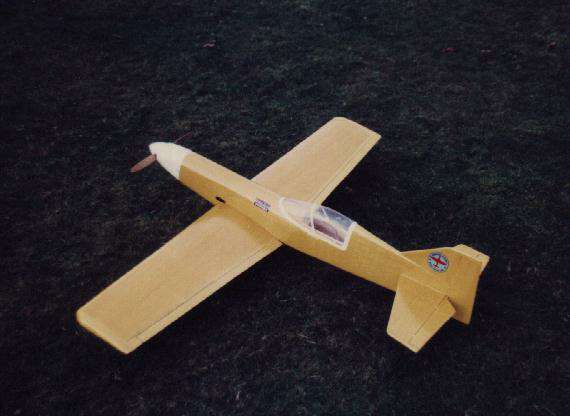Ivy and Martin's Web Page
|
The Magician is a non-scale model of pleasing design. The structure is a combination of sheet balsa and veneered polystyrene foam.
It requires a .40 2-stroke engine and 4-channel radio. The wingspan is 50 inches and the weight should be between 4 and 6 lb.
The plans as supplied show the structure of the fuselage and tail in detail while the wings only need simple diagrams. There are sufficient instructions. The quality of materials supplied is good, with accurate cutting of the ply parts and high-quality veneered foam components. The clear canopy moulding is good and there is a 2-piece vacuuum-formed ABS plastic cowling.

Structure The fuselage sides are cut from balsa sheet. The sides are joined by plywood formers at the front and balsa ones further back. The forward top decking is a veneered foam unit, the rear upper fuselage being made from balsa sheet and block. Care needs to be taken in cutting the slot for the tailplane, which is part-way up the rear decking sides. The fuselage is finished by adding the clear plastic canopy and gluing balsa sheet and block on the underside. The engine is mounted sideways on a radial mount bolted to the front 1/4 inch ply bulkhead. The ABS plastic cowling is a good fit, but will need careful trimming to fit around the engine. The main undercarriage consists of a pair of piano-wire struts and is intended to be fixed to a ply bulkhead just forward of the wing position, and this is perfectly satisfactory. I decided to fit mine instead with a pair of retract units mounted in the foam wings, just behind the leading edge.
The wings require very little work. Attach the balsa strip leading and trailing edges and block wing tips to the foam panels and trim them to shape, then epoxy the panels together.
The joint needs to be reinforced with glasscloth and resin. Balsa sheet strip ailerons are fitted the full length of each panel.
The tailplane and fin are made from 1/4 inch sheet balsa, the complete tail assembly being permanently attached to the fuselage. The whole model is treated with sanding sealer and tissue covered. There is plenty of space for the radio installation in the space above the wing. The rudder and elevator are driven by plastic snake rods. The aileron servo is mounted in the centre of the wing, driving internal aileron cranks. Flying the model This model is designed for aerobatics and goes where you point it. It is fast (especially with the undercarriage up) and capable of most manoeuvres. Take-off requires very little rudder correction, although mine, with it's wheels more to the rear than standard, requires some "up" elevator to be held most of the way. A fixed-undercarriage one I flew for a while had no nosing-over problems. Landings are easy, although the glide is fast and flat. Structural Assessment This design follows common practice in small aerobatic model kits with it's balsa sheet and veneered foam construction. It posesses more than adequate strength without being overweight. Final verdict This is an easy model to build and a very good flyer in experienced hands. Not one for the beginner. |
|
Other people's comments on the Magician kit:
From Stephen Cope: I built this model about 8 years ago, a very nice model to build and fly, very positive but I did find ground control a little bit erratic. Further to that I did move the undercarriage forward which seemed to make it a bit more docile. Sorry to say it has now met its maker in the sky due to fuel contamination. From Chris Ackroyd:
I built a Magician about 3 years ago and converted it to electric. Build is very simple, although all from plan (no instructions). It flies brilliantly, super stable and nicely aerobatic; one of my best flying models in fact. Ordered the kit from Galaxy Models (obviously), but Pegasus also make the kit and they offer a fibreglass cowl, which is far nicer than Galaxy's flimsy ABS one supplied.
|
Have your say! Do you have any comments, observations, experience you would like to add? Do you agree with the above, or disagree?
All valid contributions will be added to the review, credited to you. Simply fill in the form below and click the "send form" button.
None of your personal information will be passed to anybody else for any purpose whatsoever.
| Back to Kit Review Index | Main Index | Martin's Photography on Picfair | Our stuff on Redbubble | Email Martin |